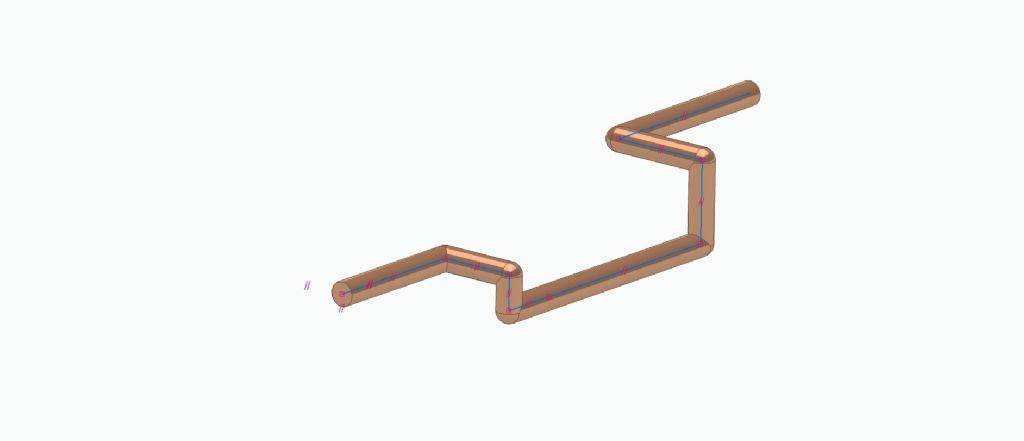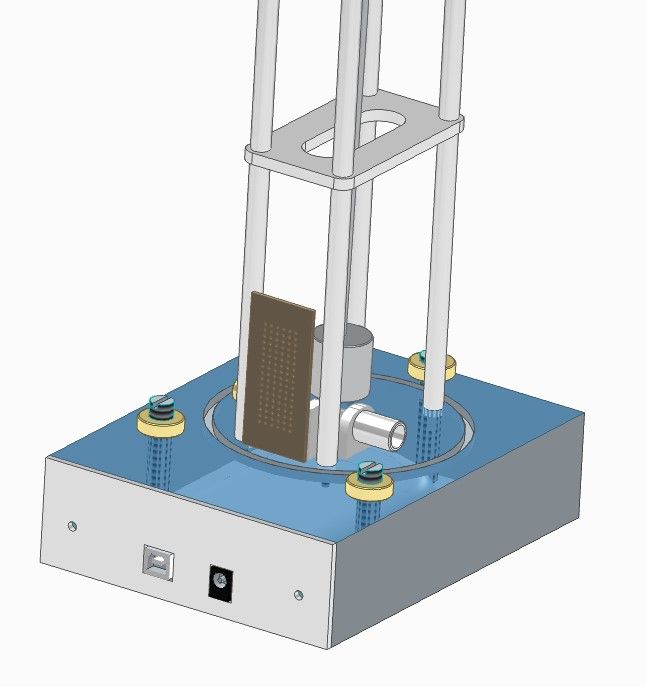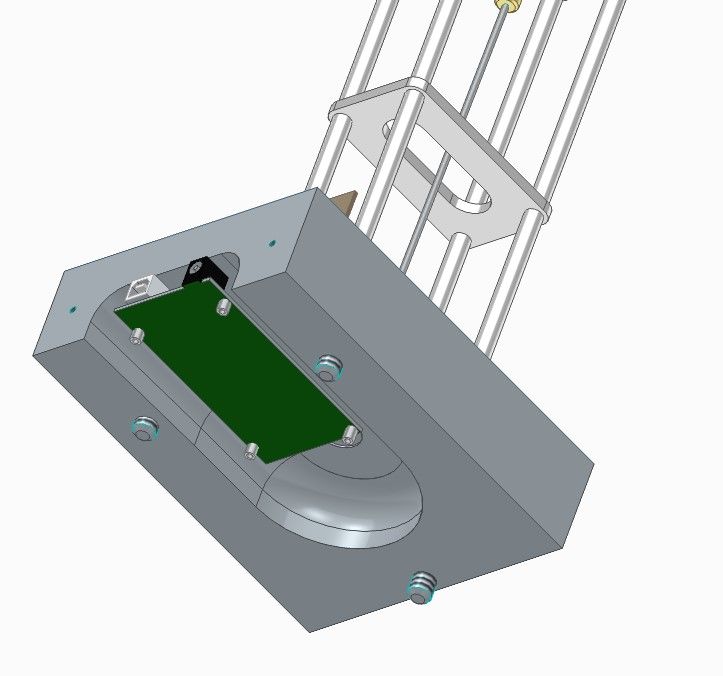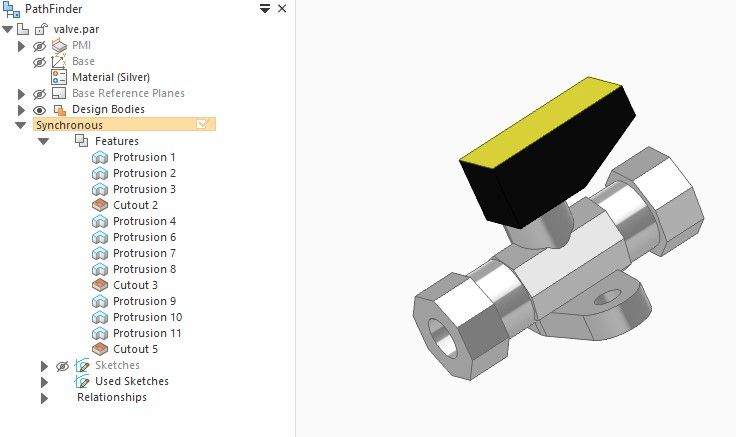3D pipe runs in CAD
First attempt at a pipe run in 3D
| IanT | 01/05/2023 15:27:09 |
| 2147 forum posts 222 photos | Posted by SillyOldDuffer on 01/05/2023 13:01:37: "The problem is me. I've been using the 2D sketcher for months. The 3D sketcher is similar, and I've forgotten the differences, so it doesn't do what I'd expect (in 3 dimensions)." Dave "Isn't it just a matter of starting a line/curve in one view (say Front) and then continuing into Top and the Left view etc, until you have the shape you need, then finishing with a Sweep to make the solid?" Martin. Thought I'd better stop hi-jacking Nigel's Alibre notes... Not tried this in Solid Edge before. Drew a (random) 3D line using simple vertical/horizontal controls (very easy in 3D Sketching) and was then left puzzled about fleshing this out into a pipe run... I did it without too much of a struggle by using the 'line' as a template and extruding cylinders down each line, changing the reference planes as I went. I then went back and rotated 'ends' onto each pipe bend... It gave me what seems to be a workable solution but I'm not sure it's how an expert would do it - I'm probably missing something simple? Regards, IanT
Edited By IanT on 01/05/2023 15:30:36 |
| Ady1 | 01/05/2023 15:41:42 |
6137 forum posts 893 photos | I would think that the more pricey 3D sketch software would be vastly superior for navigating around say a loco cab with micro piping All your pipe turns are 90 degree 2D sketch moves, to go 3D I would have to start setting up fancy planes at fancy angles instead of the click-click of 3D working |
| IanT | 01/05/2023 15:53:23 |
| 2147 forum posts 222 photos | I was just trying to roughly emulate Martin's example in the Alibre thread Ady. I did simple turns as it easy to do in SE but you can define alterate angles for them. There are also several 'routing' and 'point-to-point' options in 3D Sketching that I imagine you can apply to an assembly as you suggest. So I think there is some 'automation' available for these things but I have first to learn to walk before I can run. Regards,
IanT Edited By IanT on 01/05/2023 15:56:44 |
| Ady1 | 01/05/2023 16:06:30 |
6137 forum posts 893 photos | Sorry, didn't realise you're just practicing I've realised the limitation of Atom is proper 3D drawing which the more pricey software allows 3D drawing may also unleash our mojo where things like furniture design and architecture are concerned |
| Andrew Johnston | 01/05/2023 16:15:52 |
7061 forum posts 719 photos | I'd use a sweep function with a circle swept along a 3D path, as required. Mechanical CAD packages are not great for pipework. There are add-ons and standalone applications specifically for pipework, mainly aimed at the professional user. In a similar way electronics CAD packages are not good at specifying wiring harnesses. Again there are add-on or standalone applications which ease the specifying of wiring harnesses. Andrew |
| JasonB | 01/05/2023 16:23:53 |
25215 forum posts 3105 photos 1 articles | Old video of it being done in Alibre |
| Ady1 | 01/05/2023 16:34:28 |
6137 forum posts 893 photos | Wow and that interface is a whole new universe |
| Martin Connelly | 01/05/2023 16:46:27 |
2549 forum posts 235 photos | I used to get pipe data as a coordinate table on a drawing, use the coordinates to put the shape into 3D CAD, fillet the bends to the correct radius then sweep a circle along each line segment. I was then able to test if it could be manufactured as drawn by putting into a 3D model of the CNC pipe bender's head. and checking any dodgy bends that looked like they would cause the part to clash with the machine. Martin C |
| SillyOldDuffer | 01/05/2023 17:15:11 |
| 10668 forum posts 2415 photos | What I'm doing is a little more than a pipe run. I'm building a clock, where the pendulum swings in a vacuum. The clock base looks like this, scale, the block is140x240x48mm. I have a vacuum pump which will connect to a bunch of 8mm plumbing attached to the block:
Not much space inside the block, which also contains a microcontroller:
Needs planning, the hose and valve have to be firmly supported, the gauge visible, and the pipework routed into the vacuum chamber without getting in the way of anything else. Ideally the penetration point won't be too near the bob inside the clock because pumping out will disturb it. So I'm modelling the parts to see how they might be attached to the model clock assembly. I did the valve without bother, just has to be the right size and shape: I may use up to three elbows, and it was modelling one that gave me grief yesterday:
The pipe is made by sweeping a circle along a line representing the elbow bend, and I'd forgotten how to change plane in the 3D sketcher. It's easy when you know how! The sweep creates a solid rod, which I hollow out with the 'Thin Wall' tool. This particular tool finishes with a right-click, which I'd forgotten, and also how to tell it to do a pipe open at both ends. It produces a closed tube by default. Next I have to model the T coupler, hose fitting and gauge. Once they're available, the parts can be added to the clock assembly and interconnected with a pipe run created by the 3D sketcher. The 8mm pipe can be modelled as a solid rod, but the other components need realistic 8mm holes because the pipe plugs into them. I could work the plumbing out by positioning real parts around the real clock, but I've found CAD modelling is so close to real machining that it's worth modelling to be sure holes, pipes and whatnot won't accidentally interfere. For example, I can make holes and run pipes in the model with the model microcontroller fitted in the base, seeing instantly if any of them are bad news. Not a good idea to machine actual metal with delicate electronics or anything else attached! Dave
|
| blowlamp | 01/05/2023 17:20:57 |
1885 forum posts 111 photos | There are no special tools to do this in MoI, just draw the line and Sweep the profile. Notice how there's no need to position the profile on the rail - as long as the profile is outside the bounding box of the rail, then MoI will assume you want it rotated & centred along the rail. If you position the profile yourself, then it will be swept accordingly. By adding Points to the curve, you can see that it's possible to create more complex shapes - the generated solid can be updated by moving the Points, or even by updating the diameter of the profile.
Martin.
Edited By blowlamp on 01/05/2023 17:32:37 |
| blowlamp | 01/05/2023 17:29:06 |
1885 forum posts 111 photos | Posted by SillyOldDuffer on 01/05/2023 17:15:11:
I could work the plumbing out by positioning real parts around the real clock, but I've found CAD modelling is so close to real machining that it's worth modelling to be sure holes, pipes and whatnot won't accidentally interfere. For example, I can make holes and run pipes in the model with the model microcontroller fitted in the base, seeing instantly if any of them are bad news. Not a good idea to machine actual metal with delicate electronics or anything else attached! Dave
I think I'd be using Kunifer brake pipe (or similar), to keep it more compact, it's easier to bend too.
Martin. Edited By blowlamp on 01/05/2023 17:30:17 |
| Jelly | 01/05/2023 17:44:15 |
474 forum posts 103 photos | Posted by Andrew Johnston on 01/05/2023 16:15:52:
I'd use a sweep function with a circle swept along a 3D path, as required. Mechanical CAD packages are not great for pipework. There are add-ons and standalone applications specifically for pipework, mainly aimed at the professional user. In a similar way electronics CAD packages are not good at specifying wiring harnesses. Again there are add-on or standalone applications which ease the specifying of wiring harnesses. Andrew Indeed. My experience is that if you don't have access to Plant3D (AutoCAD)/ Modular Plant Design (Solid Edge)/ MEP (Revit) or one of the many add-in or standalone piping design programmes, it is simpler and easier to ignore 3D modelling of the pipe systems and just do your piping iso's in 2D cad or by hand. This is based on designing large runs of DN50-DN200 (2"-8" Given the Piping Iso is the ultimate product of a piping design process which communicates design intent to the fabricator, 3D models of the elements are non-essential. |
| SillyOldDuffer | 01/05/2023 18:06:49 |
| 10668 forum posts 2415 photos | Posted by blowlamp on 01/05/2023 17:29:06:
Posted by SillyOldDuffer on 01/05/2023 17:15:11:...
...
I think I'd be using Kunifer brake pipe (or similar), to keep it more compact, it's easier to bend too. ...That's where I started, but I couldn't find anyone selling all the bits needed to complete the system. Maybe I was unlucky, but 8mm was the smallest size in which I could find all the bits off-the-shelf. It's not because I didn't think of brake pipe. If anyone provides a link to a seller who could have supplied the needful, I shall have a tantrum! Dave |
| JasonB | 01/05/2023 18:17:42 |
25215 forum posts 3105 photos 1 articles | Dave, can't you download files for those plumbing fittings off the net to save having to model them |
| David Jupp | 01/05/2023 18:39:51 |
| 978 forum posts 26 photos | You might find a wider variety of valves/fittings/ tubing/connectors in inch sizes - a lot of instrumentation tubing is fractional inch sized based on tube OD.
|
| SillyOldDuffer | 02/05/2023 10:32:34 |
| 10668 forum posts 2415 photos | Posted by JasonB on 01/05/2023 18:17:42:
Dave, can't you download files for those plumbing fittings off the net to save having to model them No excuses - I didn't think of it! In similar vein, Blowlamp and DavidJ's alternatives to 8mm make me wish I'd asked for vacuum system advice before plunging in at the deep end. Not doing so has made life difficult because I have almost no experience in pipework beyond domestic water, and could have got expert help.
Dave |
| JasonB | 02/05/2023 10:51:00 |
25215 forum posts 3105 photos 1 articles | I'd have gone with push fit pneumatic myself, 4, 6, 8 and 10mm easily available and if you plumb it up wrong the first time you can pull it apart and start again. PVC pipe is flexible so you can run it as you wish |
| David Jupp | 02/05/2023 11:11:53 |
| 978 forum posts 26 photos | Most small bore valves/fittings are designed primarily to keep pressure in - they may not necessarily perform as well if required to keep pressure out (though many will probably be OK). You may want to check for if components are suitable for vacuum duty. |
| SillyOldDuffer | 02/05/2023 12:07:21 |
| 10668 forum posts 2415 photos | Posted by David Jupp on 02/05/2023 11:11:53:
Most small bore valves/fittings are designed primarily to keep pressure in - they may not necessarily perform as well if required to keep pressure out (though many will probably be OK). You may want to check for if components are suitable for vacuum duty. I'm worried about that! It's why I avoided push-fit. Soldered fittings should be fine, and I guess compression joint olives will be OK too. Not sure about the gas tap, but I expect it's a ball-valve. The vacuum gauge and BSP adaptor should be OK. The danger points appear to be the fitting that penetrates the base and the seal built into the top of the pipe, which is the wrong way round for a vacuum but I can glue the cap as well. Biggest concern is the o-ring or sealant at the bottom of the 4" pipe where it sits in a groove cut in the base. It relies on the weight of the pipe and air pressure to maintain the seal. If it leaks, Plan B is to glue a 3D printed flange to the pipe allowing it to be screwed down to the base. I don't know yet how good the vacuum will be even if there are no leaks. The pump is an elderly old banger like me. Assuming I get to pumping it out - still struggling to get the electronics working reliably. Dave |
| JasonB | 02/05/2023 12:14:31 |
25215 forum posts 3105 photos 1 articles | My vacuum press uses the push fit connections and it's a very popular model so must work OK |
Please login to post a reply.
Want the latest issue of Model Engineer or Model Engineers' Workshop? Use our magazine locator links to find your nearest stockist!
Sign up to our newsletter and get a free digital issue.
You can unsubscribe at anytime. View our privacy policy at www.mortons.co.uk/privacy
- hemingway ball turner
04/07/2025 14:40:26 - *Oct 2023: FORUM MIGRATION TIMELINE*
05/10/2023 07:57:11 - Making ER11 collet chuck
05/10/2023 07:56:24 - What did you do today? 2023
05/10/2023 07:25:01 - Orrery
05/10/2023 06:00:41 - Wera hand-tools
05/10/2023 05:47:07 - New member
05/10/2023 04:40:11 - Problems with external pot on at1 vfd
05/10/2023 00:06:32 - Drain plug
04/10/2023 23:36:17 - digi phase converter for 10 machines.....
04/10/2023 23:13:48 - More Latest Posts...
- View All Topics
- Reeves** - Rebuilt Royal Scot by Martin Evans
by John Broughton
£300.00 - BRITANNIA 5" GAUGE James Perrier
by Jon Seabright 1
£2,500.00 - Drill Grinder - for restoration
by Nigel Graham 2
£0.00 - WARCO WM18 MILLING MACHINE
by Alex Chudley
£1,200.00 - MYFORD SUPER 7 LATHE
by Alex Chudley
£2,000.00 - More "For Sale" Ads...
- D1-3 backplate
by Michael Horley
Price Not Specified - fixed steady for a Colchester bantam mark1 800
by George Jervis
Price Not Specified - lbsc pansy
by JACK SIDEBOTHAM
Price Not Specified - Pratt Burnerd multifit chuck key.
by Tim Riome
Price Not Specified - BANDSAW BLADE WELDER
by HUGH
Price Not Specified - More "Wanted" Ads...
Do you want to contact the Model Engineer and Model Engineers' Workshop team?
You can contact us by phone, mail or email about the magazines including becoming a contributor, submitting reader's letters or making queries about articles. You can also get in touch about this website, advertising or other general issues.
Click THIS LINK for full contact details.
For subscription issues please see THIS LINK.
Model Engineer Magazine
- Percival Marshall
- M.E. History
- LittleLEC
- M.E. Clock
ME Workshop
- An Adcock
- & Shipley
- Horizontal
- Mill
Subscribe Now
- Great savings
- Delivered to your door
Pre-order your copy!
- Delivered to your doorstep!
- Free UK delivery!








 piping comprising multiple spools with complex geometry to fit round various constraints like existing pipework and supports.
piping comprising multiple spools with complex geometry to fit round various constraints like existing pipework and supports.








 Register
Register Log-in
Log-in


